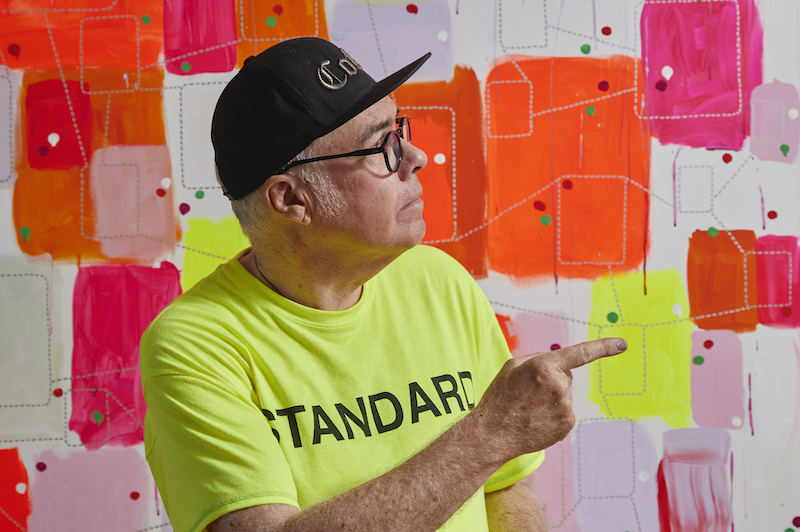John Reynolds: Walk with Me
An ongoing project by Auckland-based painter John Reynolds explores the lost hours and last days of the great Colin McCahon.
Words: Emil McAvoy
Photography: Sam Hartnett
“MY INTENTION is to think through Colin McCahon, rather than think about him.” These are the words of John Reynolds, whose Missing Hours presentation at Auckland Art Fair 2019 is an ongoing project mining the disappearance of the great painter in 1984. McCahon, New Zealand’s most celebrated artist, went missing in Sydney’s Royal Botanical Gardens and was found five kilometres away the next morning disoriented and confused, unable to remember his own name or where he had been. Found by Australian police, he was taken to a local hospital for observation while his Sydney Biennale exhibition opened across town. Recognised by a nurse from a newspaper photograph covering the show, he was soon reunited with his family and friends. The event also foretold McCahon’s decline… McCahon had developed Korsakoff syndrome from decades of alcohol abuse and would pass away three years later. What happened during those lost hours remains a mystery.
For Reynolds, ever playful and with a light- ness of touch, the episode offers a rich source of inspiration and speculation. Those with Korsakoff syndrome may confabulate information they can’t remember, often believing their invented explanations. It can also result in declining spatial awareness and hallucinations. Reynolds explores these implications for McCahon’s lost hours – and indeed last days – as a kind of disoriented trip. He probes the at once true, fictive and symbolic journeys into the great beyond, journeys prefigured in McCahon’s own depictions of Christ’s movement through the Stations of the Cross situated in the New Zealand landscape.
Reynolds’ initial response was to author Martin Edmond’s version of McCahon’s lost journey in his speculative non-fiction book Dark Night: Walking with McCahon. In discussion with the artist, he articulates this interest in McCahon’s late works – and his unravelling – as a productive way in which to engage with McCahon’s ghost and reinforce the artist’s extraordinary contribution to New Zealand art without retreating to uncritical homage. Writing for Starkwhite, curator and writer Kelly Carmichael notes that he describes the ongoing investigation as “part missing person’s archive, part pilgrim- age, part art historical vagabondage”. The project opened at Starkwhite with WalkWithMe… (2016) and was followed by FrenchBayDarkly… (2017), exhibitions riffing on the titles of iconic McCahon paintings.
Reynolds’ Missing Hours paintings similarly map inner and outer journeys, a cartography of the real and imagined. Reynolds describes territories, systems and structures collapsing and dissolving. Loose brushwork and painted markings made with his fingers echo McCahon’s use of these techniques. A dynamic palette of rectangular forms with rounded corners double as thought bubbles and parks seen from above. Graphic lines in silver marker over fields of colour chart spaces (such as the Botanic Garden and its surrounds) from an aerial view. These graffiti-like markings also inscribe words, symbols and diagrams, delineating Reynolds’ own mind maps (or Head Maps as he calls them) which think through McCahon; fragmented visions, streams of consciousness and labyrinths of imagination.
On the anniversary of McCahon’s disappearance in April this year, Reynolds hosted McCahon’s Way – A Great New Zealand Walk, a Sydney-based event that began where McCahon disappeared and ended in Centennial Park, where he was found 28 hours later. The event at once retraced McCahon’s possible journeys through the physical space as a kind of psychogeography, and reconsidered the legacy and mythology surrounding the painter.
Reynolds is now, in his own right, one of New Zealand’s most recognised artists. Writing for Paperboy, critic Anthony Byrt notes that along with others such as Judy Millar and the late Julian Dashper, Reynolds is part of a new generation that grappled with the pervasive influence of McCahon, while imagining bold new forms for art in Aotearoa. Reynolds has an extensive national and international exhibition record and is well represented in public and private collections. He is the recipient of a Laureate Award from the Arts Foundation of New Zealand and has been a finalist in New Zealand’s prestigious Walters Prize. He is currently exhibiting The Falls, a large-scale wall painting project on the Dunedin Public Art Gallery’s Big Wall.
This article was originally published in Auckland Art Fair Special Edition Art Collector, 2019.











